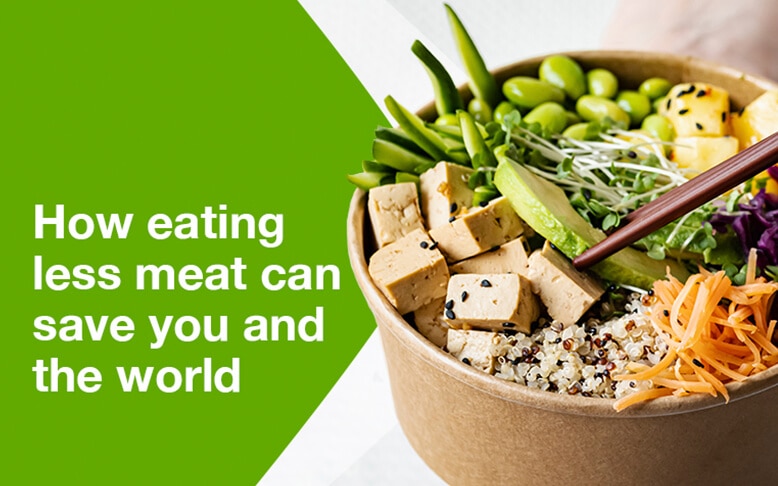The Visible Layer: Establishing Common Knowledge
Recent events placed the spotlight on the underlying socio-economic and environmental process of disease development covering the matters of climate change, urbanization, and globalization. In search of answers, food choice and diet have been found to provide significant and sustainable solutions in terms of reduction of global mortality, greenhouse emissions, and conservation of biodiversity. With this continued search, it is also essential to learn that:
- The public is slowly being aware of the impact the food system contributes to climate change, yet making the necessary changes in practice remains minimal and among a minority.
- The occurrence of an alarming succession of infectious disease outbreaks and the rising prevalence of non-infectious lifestyle diseases over the years spooked global public health.
Diving Deeper: Our Focus Culprit
The industry of meat production and meat consumption are both scrutinized for their significant contribution to the number of greenhouse gases released that resulted to global warming. Both have also been found to have a negative influence on water footprint. Apart from these negative environmental contributions, it has been found to affect the human body negatively as well. Although meat contributes essential nutrients to the diet, studies have reported that its consumption is a risk factor in developing non-communicable diseases such as cardiovascular disease, diabetes mellitus, and cancer. Moreover, dietary animal consumption was associated as a risk factor for virus infection that causes pandemics.

Did you know
Production of 1 kg of beef produces 27kg of greenhouse gases (CO2-equivalents) as compared to a kilogram of vegetables typically produced with less than 2kg of greenhouse gases (CO2-equivalents).1
Studies have examined the impact of the high meat trade on burgeoning diet-related NCDs.2 Animal products are high in cholesterol and saturated fats and regular high intake of animal food results in a buildup of fatty substances in the body, such as in the artery walls, resulting in impeding blood flow thus impairing bodily functions and springing several diseases like the illustrious heart disease. Seeing that this food group bears fats, it is copious in energy and hence associated with a high likelihood of obesity.3 Overnutrition/obesity is one modifiable risk factor for NCDs.
Consistent findings have noted a strong association between processed meat intake and various chronic diseases.4 Processed meat was reported to contain artificial chemical ingredients hazardous to health when consumed regularly. So, pivoting around reducing the risk factors associated with these diseases is one way to control the disease problem.
Layer 3: The History of Why
The impending focus on efficiently feeding the growing population and the increase in urbanization paved the way to mass-produce inexpensive, convenient, and large portion-sized energy-dense foods items. The aspect of growing and making food from scratch became tedious and this practice undermined local and healthier diets. Consequently, it displaced the food system and diet diversification.
With the shift, access to fresh and local food items such as fruits and vegetables was not given priority. This meant that what was made available were the cheaper high salt, sugar, fat, and calorie food items which led to unhealthy diets resulting in a dramatic rise in diseases since the consequences of poor nutrition stockpiles throughout a lifespan.5
As of the year 2018-2019, the Expanded Philippine National Nutrition Survey6 reported that the mean one-day household vegetable and fruit consumption was 15.5% and 4.1%, respectively. Intake of plant-based food as food sources at household levels has also significantly decreased from 72.8% in 2015 to 68.5% in 2019. Major reasons include increased local prices of fruits and vegetables, especially during calamities when the food production targets are overtopped by inflation.
The Savior in Plant-Based Diet

A shift toward a plant-based diet is one solution that targets the issues of human health and environmental sustainability. Changing our food choice will have a domino effect on the food system and holistically set a chain reaction in preserving the environment and health.7 Replacing animal products with plant-based options improves body weight, reduces micronutrient deficiencies and disease morbidity and mortality, and simultaneously addresses the issue of environmental impact.
A plant-based diet does not completely exclude eating meat, it simply indicates that meals are mostly from plant sources akin to a flexitarian diet. Plant foods offer an excellent opportunity to improve the health of people, animals, and their shared environment as well.8 Even when it sounds so promising, going plant-based can be overwhelming and feel like a hard reach for everyone which makes creating a list of substitutes for specific dishes a good first step.
Table 1. Sample meat dishes that can be substituted by plant sources
| Meat Dish | Plant-based Substitute |
|---|---|
Pork Sisig Pork/Chicken Adobo Chicken Afritada Chicken Tinola Unagi (Eel) Pork Siomai Bacon Sandwich/ Meat Burger | Mushroom Sisig (Oyster Mushrooms) Tofu Adobo or Soy Curls Adobo or Adobong Okra Soy Curls Afritada Oyster Mushroom Tinola Eggplant Unagi Shitake Mushroom Siomai Eggplant Sandwich/ Grilled Eggplant Burger (marinade the eggplant with soy sauce, maple syrup, olive oil, apple cider vinegar, and paprika then fry/grill) |
To further appreciate the advantages of going plant-based, check out the following information9:
- The vitamins, minerals, dietary fiber, phytochemicals, and antioxidant values of plant food sources support the maintenance of balance in the body and maximize the function of the immune system.
- A healthy immune system reduces the risk of various forms of diseases.
- The phytochemicals and antioxidant capacity of plant food items lower the incidence of inflammation and neutralize toxins brought by ingestion of processed foods, pollution, and pathogenic microorganisms. If left unsupervised, chronic inflammation may damage the cellular and tissue structures and lead to serious disease conditions.
Simply put, plant foods have the capacity to ease the triggering factors associated with disease development.
It Takes Everyone For Actual Change

The conscious effort of an individual to incorporate a plant-based meal at least once a day may influence family and peers to do the same and eventually set forth a plant-based menu for the day or weeks to come for a larger number of people. But, it should not stop there.
Food and nutrition security and climate change bold policies promoting the recommendation to minimize consumption of animal products and favor intake of plant-based food items to comprehensively support animal welfare, reduce environmental footprint, and minimize the risk of diseases are needed to be urgently put into place. For maximum optimization, there is a need for:
- Wide and massive campaigns on better nutrition for a better world awareness to create a demand for it
- Government to provide incentives and/or subsidies to plant food producers for unrestrained supply for the public
- Dramatic promotion of accessible and available healthy food items vis-a-vis ultra-processed ones
- Engagement of the food companies to reformulate and offer food items with less salt, fats, and artificial chemicals and utilize more plant-based ingredients in their products
As mentioned by experts, a plant-based diet is not a trend but a solution to combat global health problems and sustain the environment for future generations. It will, however, be hard to make healthy food choices if the environment does not provide the enabling mechanisms to offer these healthy options to diversify the diet and resolve health issues of people, animals, and their shared environment.
Message to RNDs
Let us create and recommend more plant-based easy-to-prepare recipes to entice everyone to shift. Incorporating various plant-based ingredients in typical meals will gradually increase their utilization, and consumption and hopefully be the future’s food choice once it becomes more available and accessible. We may be late in realization and action but we hope to soon widen the interest of Filipinos on the long-term benefits of shifting their diets and align ourselves towards ONE HEALTH.
Our environment basically dictates why we eat what we eat so we must take responsibility for nurturing mother nature to sustain our lives. It is time to do our part in helping to protect the earth to live well.


 Aimee Sheree A. Barrion , RND, PhD
Aimee Sheree A. Barrion , RND, PhD

















No comments here yet.